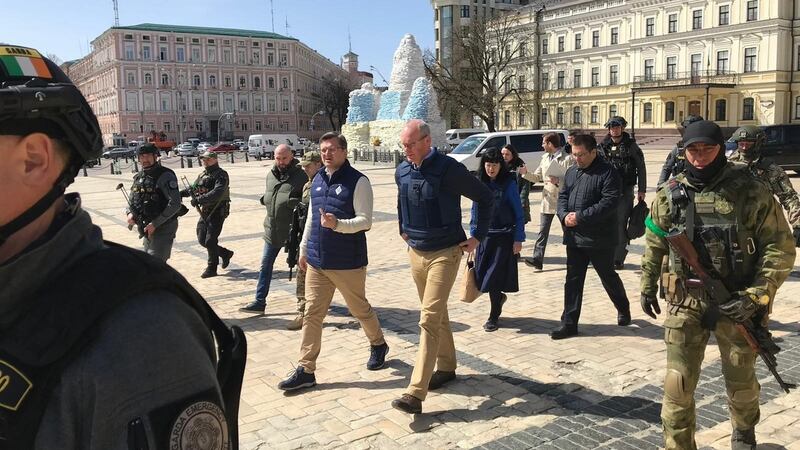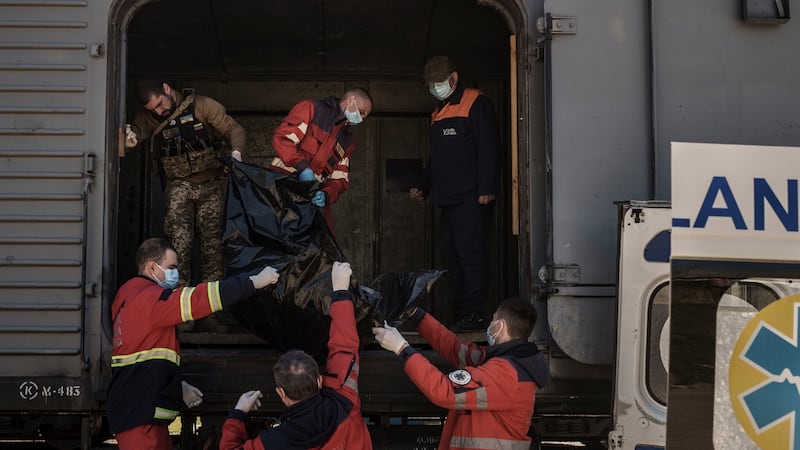On a quiet branch line in Lviv in western Ukraine, the city that was the main destination for evacuation trains that helped millions of people flee Russia’s invasion, another potentially life-saving service is drawing up to the dusty platform.
The exterior of the ageing blue-and-yellow carriages is unremarkable, but hides an intensive care unit and other refitted cabins in which the war-wounded and other patients travel from the battle-scarred east to the relative safety and less-burdened hospitals of Lviv.
It can only function because most of the country’s vast rail network is still working three months into the Kremlin’s all-out invasion of Ukraine despite repeated missile strikes on a system that is vital to the country’s military, economic and humanitarian war effort.
“We have an intensive care unit and the capacity to provide oxygen and care for patients who are fully on mechanical ventilation,” says Yasser Kamaledin, an emergency project co-ordinator for Médecins Sans Frontières (Doctors Without Borders – MSF), which adapted and operates the train.
“Sometimes we carry war-wounded patients who recently arrived at these hospitals [in the east] and were just stabilised … and we also transport patients who have been hospitalised for various chronic conditions to empty some bed capacity so that those hospitals can receive more patients if any new incident happens,” he says.
“We do regularly have patients who are freshly wounded, whether by being close to a blast … or with gunshot injuries,” Kamaledin adds, noting that MSF will treat any patient “as long as they come without weapons or a uniform”.
The train and its 18 medical and support staff left Lviv two days ago, travelling overnight to the Donbas region where they picked up patients in Pokrovsk, 50km from the frontline, then in Dnipro, a city 200km further west, before returning through the night.
Two medical trains operated by MSF have now completed more than 20 journeys, serving as what Kamaledin calls “long-distance ambulances” for a total of more than 500 patients on the 1,000km haul from Donbas to Lviv.
“MSF did not have a similar train in any of the other countries where it works. This was developed specifically for the context here in Ukraine … where you have large distances and a big number of hospitals which can receive patients here [in the west] and hospitals in the east that are being continuously overwhelmed by the number of patients.”
“In Ukraine,” he adds, “the railway network is still functional to a great extent, so this is why we chose this way of transporting patients.”
Just as Ukraine’s military has proved to be far more capable than most experts predicted, and Ukrainian society has united and mobilised in a formidable war effort, so the country’s train system has also shown extraordinary resilience and adaptability.

When Russia poured troops and armour over the border before dawn on February 24th in a bid to occupy Kyiv, Kharkiv and other major cities, millions of people began fleeing west by train towards Lviv and nearby regions and to European Union countries.
At the same time Ukraine’s allies ramped up deliveries of weapons, and these joined the flow of other military supplies, soldiers and humanitarian aid that surged east to frontline areas on a rail network that Moscow immediately targeted with cruise missiles.
“The railway system is really important for us because our airport infrastructure has been destroyed and road traffic on the border is horrible,” says Serhiy Leshchenko, deputy head of the supervisory board of Ukrzaliznytsia, Ukraine’s state rail operator.
“That’s why Russia is attacking electrical substations. Without them we can still run trains on diesel but it’s more expensive … and there is a shortage of diesel in Ukraine,” he says. “Another target is bridges … because they want to stop exports of grain and iron ore, which are two crucial export items, to make our economy weaker,” says Leshchenko, highlighting the importance of train cargo during a Russian blockade of Ukraine’s Black Sea ports.
[ Ukraine’s battlefield agility pays off in war with RussiaOpens in new window ]
The fighting has displaced about 14 million people, four million of whom fled to safety by rail, many cramming on to packed evacuation trains that through the first weeks of war streamed out of teeming stations that kept working despite constant threat of attack.
As those trains went west, others continued to run the other way, serving Kyiv even when enemy troops were in its suburbs; Kharkiv – just 35km from the Russian border – while it was under intense shelling; and other places near the frontline.
Evacuation trains are still running from Donbas as Russian forces grind forward and pummel its cities, towns and villages, but most people who are willing to leave have already done so, and many eastbound services are now busy with Ukrainians returning home to places such as Kyiv, Kharkiv and Odesa that are still firmly in government hands.
Though many stations are largely unlit after dark, and train windows are covered in an anti-shatter film of clear plastic and must be curtained at night, these services are otherwise strikingly normal – carriage attendants, who are mostly middle-aged women, still welcome passengers aboard and serve tea and coffee, and overnight trains are clean and comfortable and most are remarkably punctual.
The network has also brought dozens of foreign dignitaries to Ukraine since the Polish, Czech and Slovenian premiers were the first to visit wartime Kyiv on March 15th, including Minister for Foreign Affairs Simon Coveney in April and a delegation from the Oireachtas last week.

“I gather you’re called ‘Iron People’ – men and women of iron – because that’s the trade, the industry you work in,” British prime minister Boris Johnson said when thanking Ukrzaliznytsia staff for getting him from Poland to Kyiv last month. “But I think it also reflects the spirit that you’re showing and the spirit of Ukraine in standing up to the appalling aggression we’re seeing,” he added, while offering condolences to the families of rail staff who were among more than 50 people killed and 100 injured three days earlier when a missile hit Kramatorsk train station in Donbas.
One of Leshchenko’s grandfathers was a train driver from Lyman, an important railway junction in Donbas that Russia this week claimed to have seized, and he says Ukrzaliznytsia’s employees have played a vital part in Ukraine’s resistance to the invasion.
[ Europe Letter: ‘One hundred Ukrainian orphans arrived in the care of one adult’Opens in new window ]
“It is the biggest company in the country, with a quarter of a million workers, and as well as delivering goods and passengers they have been important for collecting information on Russian attacks on our territory, which was immediately delivered to our military commanders,” he says.
Leshchenko says rail workers also hampered Moscow’s efforts to supply its forces via the network, and played a direct role in the capture of at least one Russian soldier and armoured personnel carrier.
The rail operator also has the grim task of storing the remains of soldiers that the regime of Russian president Vladimir Putin allegedly refuses to bring home. “As of May 26th, we have 320 bags of remains of Russians soldiers stored in our refrigerator cars,” says Leshchenko, who is also an adviser to Zelenskiy’s chief-of-staff.

“The Russian army and political leadership do not care about this and so we spend our diesel keeping these refrigerators cold to store bodies that are not needed by Putin.”
The grim task, like the starkly different work of the MSF medical train that is run by international and local staff and Ukrainian support crew, relies on people who have decided to stay in their homeland and keep going despite all the risks.
“Ukrainians stepped up their game. They don’t hide at any level,” says Joao Martins, the MSF head of mission in the country, explaining how the engagement of everyone from government officials and health executives to medics and volunteers helps his organisation offer effective support in Ukraine.
“We can do this because there are these super-motivated people who have stayed here on the ground even though maybe their families have left … and they are brave enough to say, “you go and we’ll stay, and you do your part and we’ll do our part.’ It’s a group effort. On a personal level, for all of us who come here and see this,it really touches you.”





















